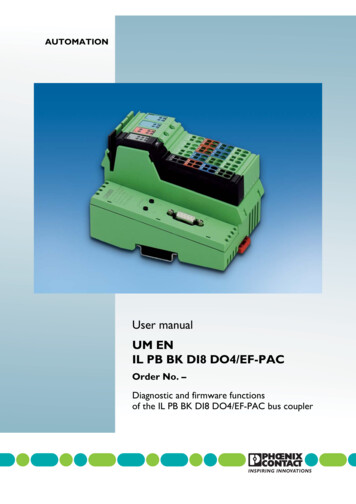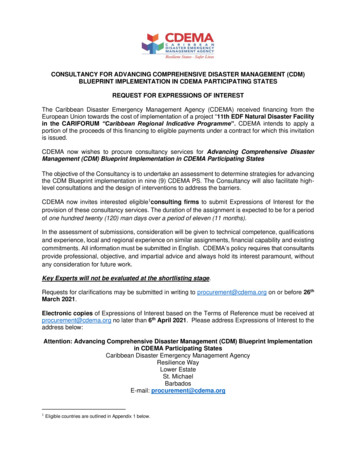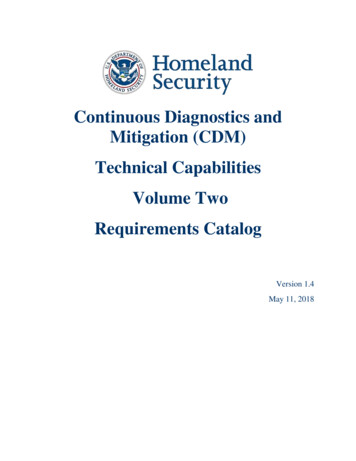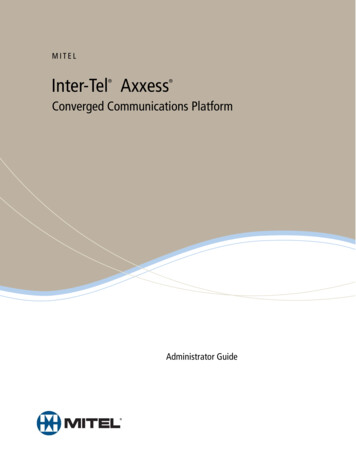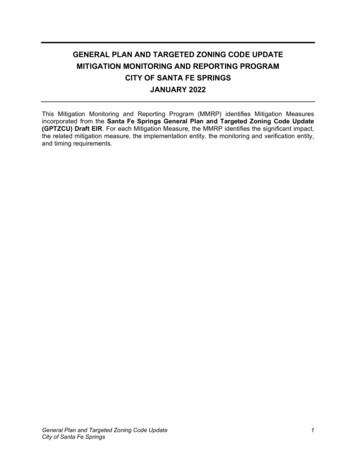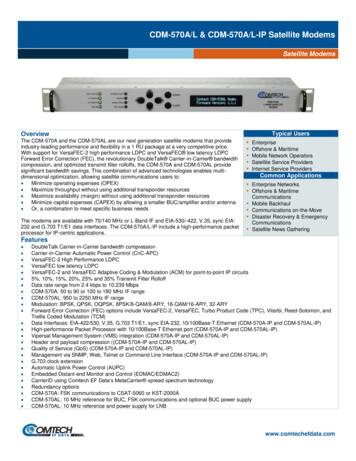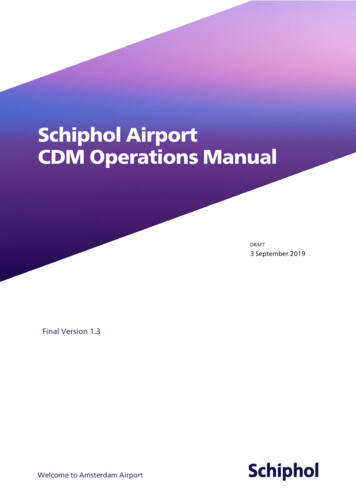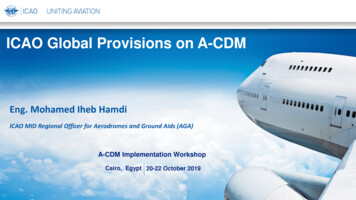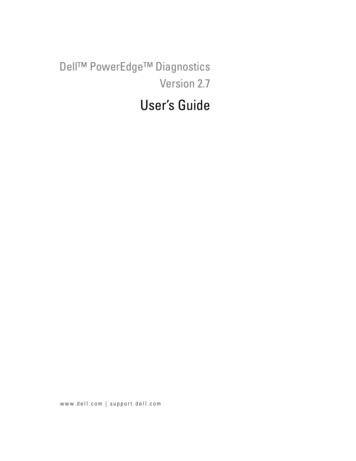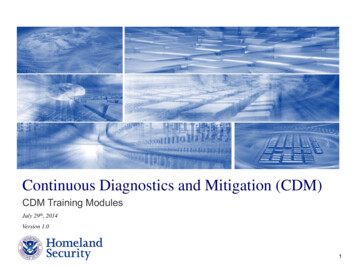
Transcription
Continuous Diagnostics and Mitigation (CDM)CDM Training ModulesJuly 29th, 2014Version 1.01
MODULE 3CDM Implementation2
Phase 1CommonImplementationIssuesHWAMCSMVULSWAM3.3 Software Asset Management(SWAM) Implementation3
Topics to be Covered1.2.3.4.5.6.Software Asset Management (SWAM) DefinitionMaking the Paradigm ShiftDeveloping a Desired State SpecificationActual StateDiscussion of D/A SpecificsSummary4
Learning ObjectivesAt the conclusion of this module, the participant will be able to:1. Describe to management why the capability is important to thesecurity of their networks.2. Identify the typical steps necessary to be taken by the department oragency (D/A) to implement SWAM and manage software.3. Identify D/A-specific steps/issues likely to affect SWAMimplementation at their D/A.4. Describe optional ways to achieve those steps and/or addressissues.5. Select the best set of options for implementation at their D/A.5
Topic: Software Asset Management(SWAM) Definition6
SWAM DefinitionWhy Continuous Diagnostics andMitigation?How does CDM Work?CDM ProgramOperational MetricsAssetsSuccessful Attacks(Outputs)Attacks/ Attack Models(Inputs)Attacker ProgramControls / Checklists(Inputs)High ImpactLowHighImpactImpactHigh pability Metrics7
SWAM DefinitionWhy SWAM?Many cyber attacks today focus on the software usedwithin an organization APT - Advanced Persistent Threats An adversary that possesses sophisticated levels of expertise and significant resources which allow it tocreate opportunities to achieve its objectives by using multiple attack vectors (e.g., cyber, physical, anddeception). These objectives typically include establishing and extending footholds within the informationtechnology infrastructure of the targeted organizations for purposes of exfiltrating information,undermining or impeding critical aspects of a mission, program, or organization; or positioning itself tocarry out these objectives in the future. The advanced persistent threat: (i) pursues its objectivesrepeatedly over an extended period of time; (ii) adapts to defenders’ efforts to resist it; and (iii) isdetermined to maintain the level of interaction needed to execute its objectives. Zero Day Exploits An attack on a piece of software that has a vulnerabilityfor which there is no known patch8
SWAM DefinitionWhy Advanced SWAM?Advanced SWAM Techniques can block most APTsand Zero Day threats by Explicitly tracking “trusted” executables for approvedSW; for example, by location, by hash or by certificate. Preventing other SW from executing. SW for APTs and Zero Day threats won’t run because theyare not on the approved list. Operationally, this is a maturity level that may take a fewyears to grow into.9
SWAM DefinitionSWAM CDM Capability DefinitionSWAM addresses attacks that seek to exploit unauthorized and undetectedmalicious software.It does this by: Identifying all software Determining whether the software is authorized and managed Taking appropriate action for the software that is notBlocking unauthorized software can prevent many phishing attacks and zeroday exploits.10
SWAM DefinitionSWAM is a CDM Capability A CDM capability is defined by: Attack scenarios – the threat Objects under attack Concept of Operations (CONOPS) Clarification of how the capabilities work together(differentiation)11
SWAM DefinitionSWAM Attack Scenario Unauthorized SW product/executable is on a deviceand vulnerable, placed by: Malicious actor or agent User Administrator Vendor, etc. Malicious Actors (threat source) Search for and exploit unauthorized software Leverage unauthorized software to compromise orharm systems and data, such as: Gain control of target machines Exfiltrate data12
SWAM DefinitionSoftware Assets in CDMDefinition: SoftwareProgram or set of programs used to run a computer (ISO/IEC 26514:2008 Systems andsoftware engineering--requirements for designers and developers of user documentation, 4.46) Software Executables* An individual file made up of instructions to the CPU Machine-level instructions or interpreted code Sample of file types: .app (Mac OS), .bat (Windows), .cmd (Windows), .jar(Java), .ksh (Linux), .run (Linux) Software Products* A software product includes the set of software executables within a specificsoftware release May be commercially produced, open source, or locally developed at the D/A A new patch or version is treated as a new product because it modifies its set ofsoftware executables Example: Microsoft Word 2010, version 14.0.6129.5000*Having the right patch level is covered in Vulnerability Management, not SWAMSoftware executables are the focus of SWAM.13
SWAM DefinitionSWAM CONOPS SWAM uses the followingconcepts: Blacklisting Software assets we don’ttrust Whitelisting Software assets we considertrustworthy Graylisting Software assets we don’tknow whether we can trustor notBacklistingWhitelistingGraylistingEach software assets isidentified as being on one ofthese lists14
SWAM DefinitionSWAM CONOPS Option 1 Blacklist FocusExplicitBlacklistingImplicitWhitelisting Option 2 whitelist FocusExplicitWhitelisting Option 3 Combined citGraylistingImplicitBlacklisting15
SWAM DefinitionSWAM CONOPSFederal Blacklisted Software AssetsTypes:1. Known bad by reputation2. Known bad by behavior3. No known business use4. Product no longer supported (patching) by vendor5. SW vendor NOT known to actively report security defects and promptlyissue patches to fix them, for its supported products.6. Not in an acceptable location and/or7. Unsigned mobile code (including invalid certificates)16
SWAM DefinitionSWAM CONOPS Blacklisted Software Assets Explicitly defined based upon prior criteria Other products should be implicitly found on the whitelist or graylist Examples Software threats detected by anti-virus programs Known badImportant point: If SW is on two lists, blacklist trumps whitelistWeakness of blacklisting: We cannot possibly know all bad software17
SWAM DefinitionSWAM CONOPSFederal Whitelisted Software AssetsSoftware asset that is not blacklisted and one or more ofthe following:1. The agency has approved the SW and established a settingsbenchmark2. There is a Federal USGCB, CDM, STIG, etc benchmark3. Whitelisted by at least 3 CFO Act agencies4. Used by at least 15 CFO Act agencies5. Agency has established authorized installer accounts (with no internet oremail access) for trusted/trained installers, and SW was installed by them,and subsequently reviewed and approved.18
SWAM DefinitionSWAM CONOPS Whitelisted Software Assets Products and executables that are explicitly listed or addedbased upon prior criteria Examples Approved for use by the D/A and appropriate configurationsettings applied Ways to whitelist By productBy executable hashBy location (i.e.: C:\program files\Microsoft OfficeBy who installed the executableOther19
SWAM DefinitionSWAM CONOPSGraylisted Software AssetsSoftware asset that is not blacklisted or whitelisted and one or more of thefollowing:1. Signed mobile code with valid certificate from source not explicitly trusted2. Other SW not blacklisted and not white-listed20
SWAM DefinitionSWAM Scoring ExampleSettings BenchmarkBase ScoreNo Benchmarkand noAssessmentBenchmarkPresent but noAssessmentBlacklisted100%N/AN/AGraylisted10%Add 30%Add 15%Whitelisted0%Add 30%Add 15%21
SWAM DefinitionSWAM CONOPSSearch for and identify allsoftwareMostly CMaaS ResponsibilityCollect Actual StateOften done, by product for part of the installed software,but seldom done for all.Seldom done at the executable file level (.exe)22
SWAM DefinitionSWAM CONOPSManagers validateassigned softwareSearch for and identify allsoftwareCollect Actual StateWhitelistingand blacklistingEstablish/update a baselineof authorized and managedsoftwareCollect Desired StateThis step is seldom done At all (except for Anti-virusprotection) Or it is not current Or not in a form that can beautomatically compared to actualstateMostly D/A responsibilityCMaaS provides repository23
SWAM DefinitionSWAM CONOPSManagers validateassigned softwareSearch for and identify allsoftwareEstablish/update a baselineof authorized and managedsoftwareCollect Desired StateCollect Actual StateCompute the differencesbetween actual state anddesired state and scorethemFind/Prioritize DefectsMostly CMaaS ResponsibilityWhen both Actual and Desired State areautomated, timely, and comparable, we caneasily compute differences, which representunauthorized software.24
SWAM DefinitionSWAM CONOPSManagers validateassigned softwareSearch for and identify allsoftwareEstablish/update a baselineof authorized and managedsoftwareCollect Desired StateCollect Actual State2Remove softwarefrom actual state,if not authorizedCompute the differencesbetween actual state anddesired state and scorethemFind/Prioritize DefectsAssign a manager,if not already done.Scored defects ONLY2D/A automaticallyblacklistssoftware so itdoesn’t execute1Add software todesired state toauthorize, ifappropriate.Remove, authorize andassign for management, or(temporarily?) accept the riskof software (i.e., defects)Mitigate Defects3D/A ResponsibilityAccept risk?e.g., while investigatingThen we can take the appropriateaction25
SWAM DefinitionHow the Capabilities Work Together Hardware Asset Management (HWAM) and Software AssetManagement (SWAM) support CSM and VULN by providing areliable specification of hardware and software assets to check forknown issues. CSM / VULCSM tells you whichsettings your softwareshould have. VULN tells youwhat updates yoursoftware needs tohave. SWAM tells you whatsoftware are presentSWAMHWAM HWAM tells youwhere to look for SW26
SWAM DefinitionHow the Capabilities Work Together SWAM makes sure software is1. Identified2. Authorized3. Managed You can’t authorize software unless you identify it and make adecision on its trustworthiness.You also can’t expect it to be managed if someone isn’t assignedthat responsibility. SWAM does not address how well software on the device ismanaged, but only that the software is authorized. How well thesoftware is managed is covered by configuration settingsmanagement (CSM) and vulnerability management (VULN).27
SWAM DefinitionHow the Capabilities Work Together SWAM makes sure software is1. Identified2. Authorized3. Managed You can’t authorize softwareunless you identify it and make adecision on its trustworthiness. You also can’t expect it to bemanaged if someone isn’tassigned that responsibility.28
SWAM DefinitionWell-Managed vs. UnmanagedWell-ManagedUnmanaged Product white/blacklistedAuthorization processPatches up-to-dateSettings authorizedGraylistedProduct not approvedPatches out-of-date (VULN)Unauthorized settings (CSM) Provides a view of software management responsibility who decides what versions are allowed for the organization SWAM who configures the software CSM who patches the software VULN29
SWAM Can PreventSome Phishing AttacksSWAM Definition“By far, phishing attacks constitute the vast majority ofattacks on federal and private sector networks.”1 Phishing attacks rely on ability to launch unauthorizedand unmanaged software Whitelisting limits software the attacker can execute Mobile code management Done via current digital certificates issued from a trustedCertificate Authority (CA)1 - Federal Times, Feb. 20, 201330
SWAM DefinitionExercise Describe to management why the capability is important to thesecurity of their networks. How is my organization compromised because of unauthorized andunmanaged software: We don’t know? Mostly by software that was unmanaged? Mostly by unauthorized software being put on the network maliciously? Can your organization easily find and report 99% of the software on yournetwork(s)? Is it easy to find out who manages the software? Do you have a process to know when software should be removed?31
SWAM DefinitionMitigate Defects The following list shows the most importantdefect types and mitigation options for SWAM*: Unauthorized software Device Role Policy Violation Blacklist is out of date Non-reporting* The full set of Defects and mitigations are documented in the Software Asset Management Datasheet at http://www.uscert.gov/cdm.32
SWAM DefinitionMitigate DefectsUnauthorized SoftwareDefectDefect TypeUnauthorizedSoftwareMitigationDetection RuleIn Actual State but not in DesiredStateResponse Options Remove softwareAuthorize software ORAccept risk33
SWAM DefinitionMitigate DefectsDevice Role Policy ViolationDefectDefect TypeDevice RolePolicyViolationMitigationResponse OptionsDetection RuleActual State less secure thanDesired State Remove device from incompatibledevice role, ORUpdate policy, ORAccept risk34
SWAM DefinitionMitigate DefectsBlacklist is out of dateDefectDefectTypeBlacklist isout of dateMitigationDetection RuleActual State less secure thanDesired StateResponse Options Update the blacklist for the device ,ORRestore updating process, ORRemove device, ORAccept risk35
SWAM DefinitionMitigate tigationDetection RuleActual State data unavailableResponse Options Deploy collection capability, ORRestore collection, ORRemove device, ORAccept risk36
SWAM DefinitionOther Aspects of Software(Not the Focus of SWAM) Software suite: A collection of products from one vendor than can be purchased as a unit Might be the only way the get the products The suite might be installed as a unit The products are maintained (patched) individually E.g., Microsoft .Net Documentation Electronic files describing the software product and its use E.g., Users manuals, installation guides Data files Input/output for the software executables E.g., Databases, raw input Non-interpreted source code Languages that are not interpreted E.g., C source code, Java source code37
SWAM DefinitionOther SWAM Data about SoftwareDiscussion: In addition to vendor, name, version, and update, what other softwaredata could be collected? Accountability User(s) Installer(s) Owners(s) Supply chain Licensing data Producer(s) Distributor(s) Settings (may support or be collected byother capabilities) Frequency of use Others?38
SWAM DefinitionExerciseIdentify the typical steps necessary to be taken by the D/A toimplement SWAM and manage software. Can you explain to your management and staff how SWAM works? What are the main CMaaS contractor roles? What are the main D/A roles? How is it different from your current CONOPS? Can you explain what risks SWAM protects against and how thiscompares to your existing system? Knowing what software needs to be managed? Knowing who manages it, so you can keep a list of defects they need toaddress? Getting those defects mitigated quickly? Do all defects found have to be fixed immediately? How does risk acceptance work? Can you explain why SWAM doesn’t deal with how well the software ismanaged? What does?39
Topic: Making the Paradigm Shift40
Making the Paradigm ShiftParadigm ShiftDefinition: ParadigmA set of assumptions, concepts, values, and practices that constitutes a way of viewing realityfor the community that shares them, especially in an intellectual h.html?q paradigm)Definition: Paradigm ShiftA significant change in the paradigm of any discipline or digm shift) Paradigm shifts drastically change the way a subject is approached CDM (and ISCM generally) requires a paradigm shift for informationsecurity to allow automation Most (if not all) paradigm shifts encounter resistance from those heavilyinvested in the old paradigm41
Making the Paradigm ShiftParadigm ShiftMove fromManaging Productsto ManagingExecutablesMicrosoft Office Suitewinword.exe42
Making the Paradigm ShiftHow are softwareexecutables and products identified?Software ExecutablesSoftware Products Identified by, at a minimum: Identified by, at a minimum: Methods: Methods: Executable name(e.g., nameext.dll); and Digital fingerprint (i.e., hash) Compare or match digitalfingerprints (or SoftwareIdentification [SWID] Tagscontaining digital fingerprints) tohash library Vendor name (e.g., Microsoft); Product name (product licensed,e.g., Word 2010); Version number, including patch(e.g., 14.0.4763.1000); and Update (e.g., SP 1) Common Platform Enumeration(CPE) SWID Tag Others?43
Making the Paradigm ShiftTrust Library CMaaS tools have a “Trust Library” for softwareexecutable fingerprints The Trust Library may include some pre-whitelisteditems (those known to be trustworthy) Custom software must be added to the Trust Librarymanually44
Making the Paradigm ShiftInformation in the Trust Library General information Designated listing (white, gray, or black) Designated by Date designated Executable, identified by: Executable name Digital fingerprint Product, identified by: Product vendor Product name Version Both build version and licensing version help identify the product Build version is more important; it tells how vulnerable the product is Release Patch level CPE ID, if applicable SWID Tag, if applicable45
Making the Paradigm ShiftLocational WhitelistingC:\Program Files\*.*C:\TempHard DriveFile System(C Drive) All whitelisted software is defined in approvedpaths Easier to implement, alternative to hash Only approved installer accounts have access No email or Internet access by these accounts46
Making the Paradigm ShiftRole-based Listing ConsiderationsWhitelistNeeded forRoleNot Neededfor Role Trusted andallowedNot allowed(even if trusted)Graylist BlacklistTemporarily allowedMove to whitelist orblacklist over time (highpriority) Not allowedMove to whitelist orblacklist over time (lowpriority) Allowed if needoverrides risk (riskaccepted)Will require securitymitigation(s)Not allowedD/As define their own listing policies.47
Creating the Lists(White, Black, and Gray)Making the Paradigm Shift Start with a D/A’s software configuration control board(CCB) specification Pros Good source of authorized software Members typically represent each department and consider theirvarious missions Cons Takes too long to make ongoing decisions Labor intensive Often does not work small details such as: Patches Drivers48
Making the Paradigm ShiftWhitelist ApprovalsGlobally Example: Every device can run Microsoft Word Pros: Less administrative costs ( )Fast/easy approvals Cons: Allow toomuchSoftwareAllows software to run on devices where it is notneededMay propagate problems across the networkBy User Role Example: All financial analysts can run MicrosoftExcel Pros: Limits the use of the software to those who need itRelatively low administrative costs ( ) Cons: Allows software to run on devices where it is notneeded Example:By Device/User Jane Smith can run Microsoft WordServer ABC can run Apache Uniquely tailors environment for everyone’s needs Prohibitive administrative overhead ( ) Pros:Too Specific Cons:By Device Role Example: Database servers can run Oracledatabase software Pros: Limits the use of the software to the devices thatneed itRelatively low administrative costs ( ) Allows users to run software that may not be needed Cons:Combination of User Role and Device Role Example: All database administrators can run Oracle database software on database serversPros: Cons: Limits the use of the software to those users and devices that need it Moderate administrative costs ( )49
Making the Paradigm ShiftSoftware Installer Software installer will differ amongst D/As and could be: Person or a service account The device manager as defined under HWAM Enterprise Configuration Management Tool Application Manager End User Determination based on privileges Other?Software Install Attributes No email from system No Internet from system Account is only used toinstall software50
Making the Paradigm ShiftMoving Software fromthe Whitelist Use systematic process for un-authorizing software, e.g.: Sun-setting Software is approved for a specified period of time After the specified period, the software is removed from the whitelist Grace period for outdated version or unsupported product Software is authorized to run until a specified date After the specified date, the outdated version is removed from thewhitelist Critical vulnerability is identified Software is temporarily removed from the whitelist until a patch isreleased and applied Other? As software is un-authorized, it is moved to the blacklist51
Making the Paradigm ShiftStrive for a Small Graylist The graylist should be processed and reduced towardszero Could take months /years D/A should staff it to the size needed to achieve this Start with a repository from the CMaaS provider withtrustworthy and untrustworthy software identified (de factostandard) Priority:1. New software2. Legacy softwarea. Start with common softwareb. End with least used software If software is dormant (not needed or used), D/As maychoose to remove it entirely52
Making the Paradigm ShiftNew Software Decide who or what is authorized toinstall new software All new software installed by anapproved installer is either graylisted orwhitelisted D/A policy decision All new software installed by anunauthorized individual is blacklisted D/A policy decision53
Making the Paradigm ShiftMobile CodeDefinition: Mobile CodeMobile code is software transferred between systems and executed on a local system withoutexplicit installation by the recipient. (http://en.wikipedia.org/wiki/Mobile code) Currently, no good method to verify that the executablecode received matches the intended function For now, SWAM can: Allow/disallow mobile code to runAllow only digitally signed mobile code to runAllow code from trusted sources to runMonitor how often mobile code runs if not allowedAssign risk scores appropriately The Metrics Working Group (MWG), will decide if/how tomonitor mobile code54
Making the Paradigm ShiftCommon Platform Enumeration (CPE)Definition: Common Platform Enumeration (CPE)A structured naming scheme for information technology systems, software, and packages.Based upon the generic syntax for Uniform Resource Identifiers (URI), CPE includes a formalname format, a method for checking names against a system, and a description format forbinding text and tests to a name. (NIST, http://nvd.nist.gov/cpe.cfm) CPEs are typically identified through: Identify the executable and deduce the CPE from the executable Registry settings Software Identification (SWID) Tag CPEs are used to identify software products An example is the following name representing Microsoft Internet Explorer 8.0.6001 Beta:wfn:[part "a",vendor "microsoft",product "internet explorer",version "8\.0\.6001",update "beta"]Click here to return to "How are software executables and products identified?"55
Making the Paradigm ShiftSoftware Identification (SWID) TagDefinition: Software Identification (SWID) TagSoftware ID tags provide authoritative identifying information for installed software or otherlicensable item (such as fonts, or copyrighted papers).(http://en.wikipedia.org/wiki/ISO/IEC 19770) A SWID tag on a computing endpoint (device) provides ahigh degree of proof that the product is actually installed1 SWID tags are typically created/modified: By the software product vendors When software products are installed When software products are patched Sample SWID TagClick here to return to "How are software executables and products identified?"1Cheikes,B., The MITRE Corporation, Auditing andRemediating with CPE Names and SoftwareIdentification Tags, 12 January 2012.56
Making the Paradigm ShiftDigital FingerprintsDefinition: SoftwareDigital fingerprinting is the identification of large data files or structures using a hash function.These functions change a larger data set, sometimes known as a key, into a shorter data set,which may be called a hash. (adapted from fingerprinting ) Digital fingerprints are typically: Used to identify changes to software executables Generated by a third-party for management purposes Stored in a “hash library” Cryptographic hash function, e.g.: MD2MD4MD5 SHA-0SHA-1SHA-256/224 Digital fingerprints come from: CMaaS provider for COTS products D/A for custom products Product vendor (SWID Tag)Click here to return to "How are software executables and products identified?"57
Making the Paradigm ShiftUsing SWID tags and DigitalFingerprints to Manage Supply Chain Combination of SWID tag and digital fingerprints can validate supply chainintegrity A SWID tag can include the digital fingerprints Validate supply chain by: Computing current hash value of the software executable Comparing the computed value to the original hash value in the hash library Supply chain management needs to be worked with the software producer andcan be facilitated by the D/A’s CMaaS providerClick here to return to "How are software executables and products identified?"58
Making the Paradigm ShiftCPE vs. SWID TagCPESWID TagBoth are currently viable options for tracking software.Limited to naming the softwareproductsCould name and document all ofthe executables that make up asoftware productSlightly ahead of SWIDs in marketadoption in the U.SLess traction in the U.S.NIST standardInternational standardClick here to return to "How are software executables and products identified?"59
Making the Paradigm ShiftAnti-Virus versus SWAMDefinition: Anti-virusA generic blacklisting tool that is looking for software determined to be untrustworthy. Anti-virus can be: A tool to partially implement SWAM May or may not be necessary in the future with a tightlycontrolled whitelist SWAM also includes Whitelisting (authorization)Blacklisting (prohibition)Identifying software administrator (management)Identifying software to be configured and patched60
SWAM DefinitionPatches/Versions Effecton Software Products and Executables Patches and new software versionschange the installed softwareproduct and its executables In CDM, a different software productversion needs to be monitored A CPE is created when newsoftware versions are installed, butnot patches61
Making the Paradigm ShiftExerciseIdentify how the typical SWAM steps may differ from older ways tomanaging software. Why does SWAM require a desired state specification? Why does it need to be automated? How does the desired state specification relate to whatsoftware is authorized and who manages it? What is a Software Manager? Is that different from a software owner or user? Why does SWAM require each software to have a manager? Is the software manager better thought of as a person or agroup in my organization? Why is scoring to prioritize defects an important part of CDM(including SWAM)?62
Topic: Developing a Desired StateSpecification63
Developing a SWAM Desired State SpecificationDesired State SpecificationDefinition: Desired State SpecificationA listing of each authorized software and its managers. Oops!! What if my D/A doesn’t have acomplete desired state? Won’t getting one bean incredible amount of work? Actually, no. it can evolve naturally out of theactual state, as the D/A Identifies its actual software Adds them to desired state, grandfatheringthem Assigns appropriate governance roles for eachnew future software product/executable Works to find known bads and known goods inthe grandfathered software, over time Should be clean by the next refresh of eachdeviceHow can my organization do this?64
Developing a SWAM Desired State SpecificationInitiate Desired State - Legacy SoftwareStep 4Temporarily graylist* #all existing SoftwareStep 1(over timemove graylistto whitelist andblacklist)Move crowd-source knowngoods whitelist*Step 2(see earlier slide)Step 3Move crowd-sourcedknown bads to blacklist### (see earlier slide)* Allowed to Run # Incurs Risk if it runs65
Developing a SWAM Desired State SpecificationInitiate Desired State - New SoftwareStep 1Authorized Installer addsSoftware to whitelist*Decide to move tograylist* #orStep 2aDecide to move to blacklist###Step 2b* Allowed to Run # Incurs Risk if it runs66
Developing a SWAM Desired State SpecificationInitiate Desired State – At Run TimeGraylist* #ALLOWWhitelist*ALLOWBLOCK# Incurs risk if it runsBlacklist ### andeverything else.New APTs and Zero-days willnot be white or graylisted.They are “implicitly”blacklisted. So they won’t run.67
Developing a SWAM Desired State SpecificationInitiate Desired State – Mobile Software Keep a reputational list of trusted sources Block mobile from running If not from a trusted source If not signed with a current/valid digital certificateApproved?Denied!Reputational List68
Developing a SWAM Desired State SpecificationInitiate Desired State – Blocking If possible have a trustrepository For each executable That belongs with eachversion/patch level of product Sources Trust Library SWID Block Scenarios Block software not matching thesources (trust library or SWIDs) Block all software not on thewhitelist or graylist from running69
Developing a SWAM Desired State SpecificationExerciseIdentify the typical steps to be taken by the D/A to implementSWAM and manage software. How do we get started? Why are software identifiers critical to SWAM operations? Why do you need to know about software identifiers, if the CMaaS provideris largely responsible for deciding which to use? Which software identifiers might work best given how your network ismanaged
Software Assets in CDM Definition: Software. Program or set of programs used to run a computer (ISO/IEC 26514:2008 Systems and software engineering--requirements for designers and developers of user documentation, 4.46) Software Executables* An individual file made up of instructions to the CPU Machine-level instructions or interpreted code
